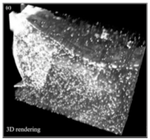Manupulation of the neural circuit
 Image by Pixabay
Image by Pixabay
Unraveling the neural circuit responsible for the mental and neurological diseases
Brain consists of multiple regions with different functions. To reveal the neural pathway delineating the specific symptoms in diseases, genetics must be one of the most powerful tool to examine the neural network based on the speciific cell types and pathways. This can be achieved by a combination of gene targeting and viral vectors.
Our lab developed such novel tools to target specific cell type such as glia for functional analyses. For example, we revealed a critical role of the astroglia in depressive-like behaviors and sleep disturbance by glia-specific viral vectors (Cui et al., J Neurosci, 2014).
This technology allows to target specific pathway embedded in the brain with help of a combination of optics and genetics (optogenetics). Indeed, we showed optogenetic inhibition of the dopaminergic pathway in the brain had antidepressant effect in mice (Cui et al., J Neurosci, 2020)

We are also successful in knocking out of the gene of our interest by combining the genome editing with viral vector. Specifically, it carries CRISPR/Cas9 cassette targeting the gene of our interest and target the brain regions, which enables the researcher to knock out the genes in any brain regions of the wildtype animals. This is how we could knock ou the gene without generating the knockout mouse line, which usually takes so long. Skipping such long processes in the experiment would facilitate the high throughput analyses of the gene functions in the lab.
Optogenetics and CRISPR/Cas9 unraveled a novel role of dopamine in stress-coping behaviors

References
Handa T, Zhang Q, Aizawa H. Cholinergic modulation of interhemispheric inhibition in the mouse motor cortex. Cereb Cortex. 2024 Jul 3;34(7):bhae290.
Cui W, Aida T, Ito H, Kobayashi K, Wada Y, Kato S, Nakano T, Zhu M, Isa K, Kobayashi K, Isa T, Tanaka K, Aizawa H. Dopaminergic signaling in the nucleus accumbens modulates stress-coping strategies during inescapable stress. J Neurosci. 2020 Sep 16;40(38):7241-7254.
Aizawa H, Sun W, Sugiyama K, Itou Y, Aida T, Cui W, Toyoda S, Terai H, Yanagisawa M, Tanaka K. Glial glutamate transporter GLT-1 determines susceptibility to spreading depression in the mouse cerebral cortex. Glia. 2020 Jun 25. in press
Aizawa H, Zhu M. Toward an understanding of the habenula’s various roles in human depression. Psychiatry Clin Neurosci. 2019 Oct;73(10):607-612.
Aikawa T, Watanabe T, Miyazaki T, Mikuni T, Wakamori M, Sakurai M, Aizawa H, Ishizu N, Watanabe M, Kano M, Mizusawa H, Watase K. Alternative splicing in the C-terminal tail of Cav2.1 is essential for preventing a neurological disease in mice. Hum Mol Genet. 2017 Aug 15;26(16):3094-3104.
Aida T, Nakade S, Sakuma T, Izu Y, Oishi A, Mochida K, Ishikubo H, Usami T, Aizawa H, Yamamoto T, Tanaka K. Gene cassette knock-in in mammalian cells and zygotes by enhanced MMEJ. BMC Genomics. 2016 Nov 28;17(1):979.
Ishizu N, Yui D, Hebisawa A, Aizawa H, Cui W, Fujita Y, Hashimoto K, Ajioka I, Mizusawa H, Yokota T, Watase K. Impaired striatal dopamine release in homozygous Vps35 D620N knock-in mice. Hum Mol Genet. 2016 Oct 15;25(20):4507-4517.
Cui W, Mizukami H, Yanagisawa M, Aida T, Nomura M, Isomura Y, Takayanagi R, Ozawa K, Tanaka K, Aizawa H. Glial dysfunction in the mouse habenula causes depressive-like behaviors and sleep disturbance. J Neurosci. 2014 Dec 3;34(49):16273-85.


